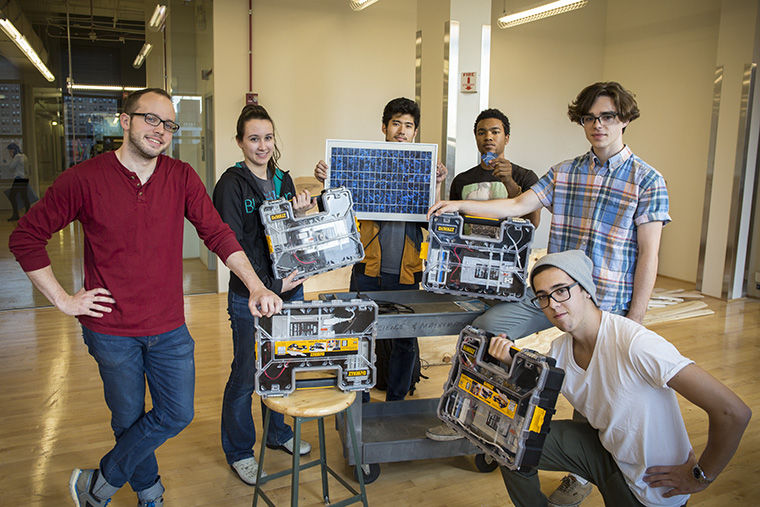Product design program faces uncertain future
Students in a product design class display a collaborative project using solar energy that they have been working on with the Science & Mathematics Department.
October 19, 2015
Columbia’s product design program, created in 1998, appears to be coming to a close, according to Kevin Henry, the program’s coordinator and associate professor in the Design Department.
About 55 students were enrolled in the Design Department’s product design program during the Fall 2013 Semester when the college halted the program’s admissions. Now, just 15 students remain, and that number is expected to drop to as low as five after the 2015–2016 academic year. This leaves many unsure of the major’s future.
Henry said he met with Tim Cozzens, chair of the Design Department, who at the time was the interim chair of the Art + Design Department; John Green, a professor in the Theatre Department who at the time was interim dean of the School of Fine & Performing Arts; and Matthew Schenoda, an associate professor in the Creative Writing Department who at the time was associate dean of the School of Fine & Performing Arts, during the Fall 2013 Semester to discuss the program’s struggle with low enrollment and its future at the college. The decision to put the program on hiatus was made during this meeting, according to Henry. The college decided to stop admitting new students but to continue the program until all its students graduated.
The meeting came after a 2011 recommendation made by Eliza Nichols, who in 2011 was the dean of the School of Fine & Performing Arts.
“There are only a few undergraduate product design programs in the country for a reason: This is a highly specialized, resource-intensive professional program,” Nichols said in a 2011 recommendation. “At a future date, if there are sufficient resources available, the college may consider a graduate program in integrated design or a five-year combined undergraduate and graduate degree.”
According to Cozzens, because admissions to the program were put on hiatus, product design was removed from Columbia’s website, which is primarily geared toward recruiting new students.
“[Product design] will still be in the course catalog, but there will not be majors in the program,” Cozzens said. “The question as to whether we still teach those courses or some of those courses is one that is currently being addressed.”
Henry said a similar program could be reinstated at Columbia, but it would require significant restructuring and collaboration with other programs.
“It would need to come back in such a way that would guarantee a larger body of students, and I think leveraging fashion design and leveraging some of the interactive technology is one way of doing that,” Henry said.
At the program’s peak, about 75 students were enrolled across all four years, Henry said, adding it is common for product design programs to be smaller than other programs at any college.
The University of Illinois at Chicago reported 105 undergraduates enrolled in its industrial design program in the Fall 2014 Student Data Book from its Office of Institutional Research.
According to Henry, product design has a history of struggling to maintain healthy enrollment by attracting new students, beginning with its creation in 1998.
“We had extremely low turnout,” Henry said. “The college did very little to advertise the program, and we had a whole series of other challenges.”
The small size of the program created issues in garnering support for it from the college, Cozzens said.
“The sheer size of [the program] always created some undue challenges,” Cozzens said. “It was always compared to larger programs, and I think in many ways it did not receive some of the support the larger programs received.”
There was significant competition with local institutions when product design was introduced that made it difficult to draw in new students, Henry said.
Several Illinois colleges have product design programs, including Southern Illinois University-Carbondale, The School of the Art Institute of Chicago, UIC and the University of Illinois at Urbana-Champaign, according to the Industrial Designers Society of America website.
When a program’s admissions are put on hiatus, students in the program are notified and reassured they will be able to complete the program, said Senior Vice President and Provost Stan Wearden. He added that factors like enrollment, ability to compete, cost, faculty interest and availability, and the relevance of a program could all influence its viability.
“We are happy to invest in a small program and help it grow if it has potential to grow,” Wearden said. “It was not that the program was small, but based on its track record, faculty did not feel it had the potential to grow.”
Wearden said the program would require reinvention to be reintroduced into Columbia’s curriculum after all of its current students graduate.
“I am supportive if the department decides it wants to bring back some aspect of [product design] as long as it can bring it back in a way that is competitive,” Wearden said.
Dexter Morrow, a 2015 product design alumnus and former president of Columbia’s IDSA student chapter, said the program allowed students to develop a wide array of skills, but it could have been improved.
“There were a couple things they could do to make it better and prepare you earlier,” said Shelby Sawyer, a senior design major. “Our portfolio class is not until the end of senior year. It would be a lot better to have it earlier on.”
Henry said because no students are currently entering the program, he thinks the effort he put into the program was undervalued.
“I have done this for 15 years, and I am extremely disappointed,” Henry said. “I cannot tell you how much time and effort I have put into this and got almost nothing to show now as a result [of the hiatus]. There is a great opportunity here, but it takes a different approach.”








